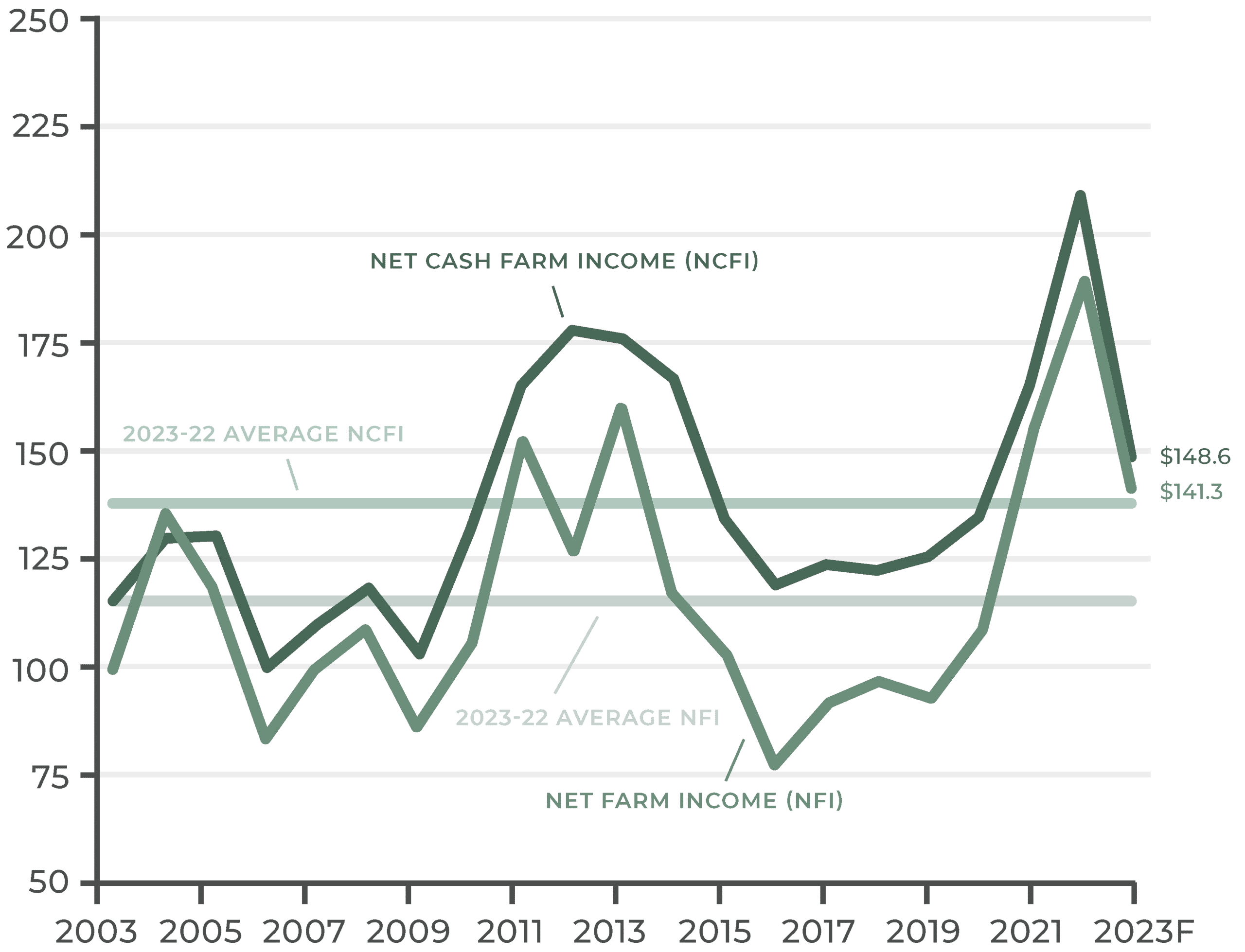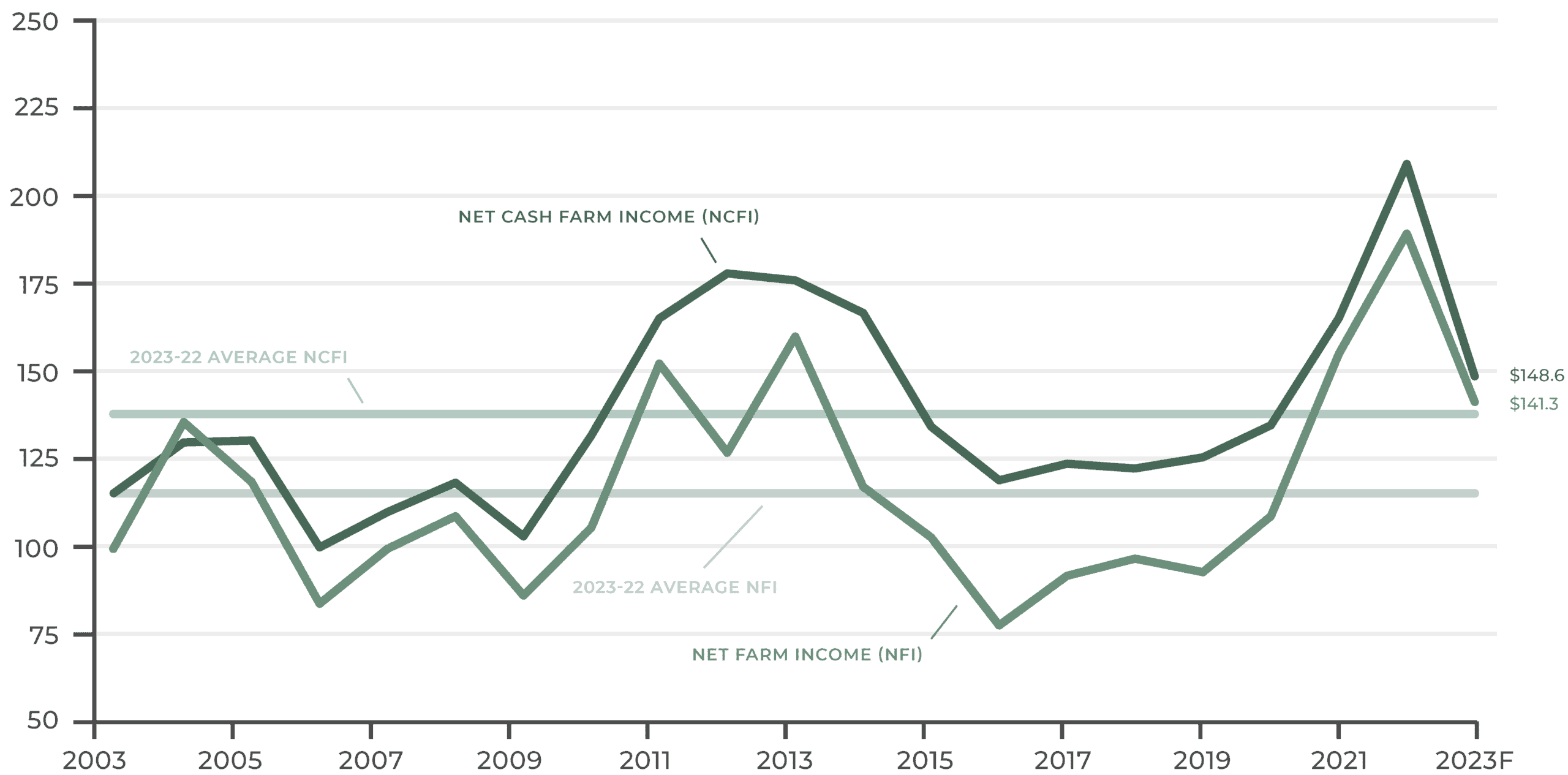Report Recap: Four Factors Impacting Farm Income in 2023
After a record high in 2022, farm income is anticipated to decline by 22 percent in 2023.
In 2022, landowners experienced record high farm income, with net farm income reaching $183 billion. But in 2023, that number is predicted to fall 22 percent. While this is still above the decade’s average, there are several factors landowners should keep in mind when planning for the year ahead.
U.S. Net Farm Income and Cash Farmer Income, Inflation Adjusted
(billion dollars)


Note: F = forecast. Values are adjusted for inflation using the U.S. Bureau of Economic Analysis Gross Domestic
Product Price Index (BEA API series code: A191RG) rebased to 2023 by USDA, Economic Research Service.
Source: USDA, Economic Research Service, Farm Income and Wealth Statistics. Data as of August 31, 2023.
The USDA Farm Sector Income Report focuses on four reasons for this downward trend—increased production expenses, decreased government farm payments, lower cash receipts, and more farm debt.
In this article, we’ll break down the most important information in the USDA farm income forecast to paint a picture of farm income in 2023 and help you plan ahead.
1. Input Costs Are Growing
Input costs hit a record in 2022, with severity ranging by sector. For example, input costs were an average of $431 per acre for wheat and as much as $1,200 per acre for rice and peanuts. Overall, production costs are predicted to increase by 6.9 percent in 2023 after accounting for inflation.
The biggest spending categories for farmers in 2023:
- Interest: +27.6%
- Livestock and Poultry: +17.9%
- Labor: +5.24%
- Feed: +3.2%
- Fuel and Oil: –14.9%
Running a farm is getting more expensive, with feed, labor, and buying animals being the biggest costs. Additionally, farmers will have to pay more in interest, but they might save on fuel and oil this year. While the USDA’s farm income forecast predicts a decline in fuel and oil costs, recent steps taken by OPEC+ nations to drive up global oil prices bear watching.
2. Fewer Direct Government Farm Payments
After a big high in the COVID era of 2020, direct government farm payments have been steadily declining, with an anticipated decline of 19 percent in 2023. The majority of this special funding, like the Coronavirus Food Assistance Program (CFAP) and the Paycheck Protection Program (PPP) have already ended or are reaching their expiration.
The Agriculture Risk Coverage (ARC) and Price Loss Coverage (PLC) programs are forecast to decline by 88.6 percent due to high prices for crops in 2022.
However, a few programs are expected to increase funding in 2023, mostly conservation programs and commodity payments. The Conservation Reserve Program (CRP) is up 10.1 percent from its previous estimate. Due to low dairy prices, the Dairy Margin Coverage Program (DMC) funding is forecast to increase 611.8 percent.
3. Lower Prices and Quantities Impact Cash Receipts
Overall, the price of crops and animals has fallen. With just the price effect in mind, farmers are predicted to earn $20.3 billion less this year. Additionally, overall sales are down. The quantity effect accounts for an additional $3.8 billion lost.
| Price Effect | Quantity Effect |
| Imagine you’re selling apples, and you sold the same number of apples in both years. But the price of apples changed. The “price effect” looks at how much your earnings would change just because of this price difference. | Now, suppose the prices stayed the same as in 2022, but you’re selling more or less apples in 2023. The “quantity effect” checks how this change in the amount you sell affects your earnings. |
Crop cash receipts are predicted to decrease four percent from 2022 overall. Corn, soybeans, and cotton are down due to lower prices and quantities sold. However, vegetables and melons are expected to earn more due to higher prices and sales. Wheat, hay, fruits, and nuts saw only minor changes in earnings.
Estimated change in crop cash receipts from 2022 to 2023:
- Cotton: -17.8%
- Corn: -9.6%
- Soybeans: -8.6%
- Wheat: -3.1%
- Fruits and Nuts: -2.3%
- Vegetables and Melons: +15.9%
Animal and animal product cash receipts are expected to decline 4.6 percent from 2022. Dairy, chicken eggs, and poultry are down due to low prices. However, cattle and calves are expected to see an increase this year, thanks to low volume driving higher prices.
Estimated change in livestock and livestock product cash receipts from 2022 to 2023:
- Eggs: -32.3%
- Dairy: -20.9%
- Broilers: -12.9%
- Hogs: -9.8%
- Cow/Calf: +17.8%
4. Farm Equity Is on the Rise
Farm equity is forecast to increase 6.8 percent to a total of $227 billion. Even though interest rates are up and working capital is down, farmers are expected to marginally improve the average debt-to-asset ratio by 0.21 percent. This means farm assets are expected to appreciate at a faster rate than farm debt is being accumulated. This can generally be seen as positive news for landowners, as it indicates an increase in the overall value of farm assets relative to the growth of debt. For tenants, various factors must be considered, including the specific terms of lease agreements and how changes in equity and debt might affect rental costs or leasing opportunities.
Estimated changes in farm equity and debt:
- Farm Equity: +6.8%
- Farm Assets: +6.6%
- Farm Debt: +4.9%
- Working Capital: -5.5%
Times Are Changing. Lending Should Too.
Long story short—farm income is historically strong, but proactive risk management should be a key piece in your financial planning during signs of a downturn. As input costs climb and government payments dry up, you deserve a lender who understands the agricultural landscape and can help you be proactive in building resilience for harder roads ahead.
At AgAmerica, your long-term financial health is our ultimate goal because we understand the importance of what you do. Contact us to learn how we can help you thrive in the good times and sleep well during the hard ones.






